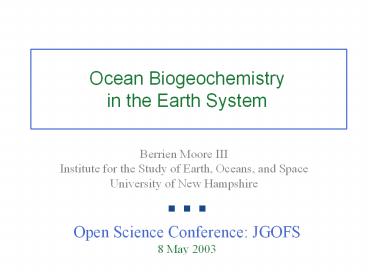Ocean Biogeochemistry in the Earth System - PowerPoint PPT Presentation
1 / 51
Title: Ocean Biogeochemistry in the Earth System
1
Ocean Biogeochemistry in the Earth System
Berrien Moore IIIInstitute for the Study of
Earth, Oceans, and SpaceUniversity of New
Hampshire
Open Science Conference JGOFS8 May 2003
2
O p e n S c i e n c e C o n f e r e n c e
J G O F S
3
Source JGOFS
4
(No Transcript)
5
(No Transcript)
6
Global mean surface temperature has increased
more than .5C since the beginning of the 20th
century, with this warming likely being the
largest during any century over the past 1,000
years for the Northern hemisphere.
Source IPCC Third Assessment Report, WG1
7
An increasing body of observations of climactic
and other changes in physical and ecological
systems gives a collective picture of a warming
world
Source of text IPCC Third Assessment Report, WG1
8
Global temperature will rise from 1.4-5.8C over
this century unless greenhouse gas emissions are
greatly reduced
Source IPCC Third Assessment Report, WG1
9
There is new and stronger evidence that most of
the warming observed over the last 50 years is
attributable to human activities.
10
CO2 Concentration in Ice Cores andAtmospheric
CO2 Projection for Next 100 Years
Projected (2100)
CO2 Concentration (ppmv)
Current (2001)
(BP 1950)
Source C. D. Keeling and T. P. Whorf Etheridge
et.al. Barnola et.al. (PAGES / IGBP) IPCC
11
(No Transcript)
12
(No Transcript)
13
(No Transcript)
14
Biological Pump
Physical (solubility) Pump
Source JGOFS / IGBP
15
(No Transcript)
16
(No Transcript)
17
(No Transcript)
18
INVERSE METHODOLOGY Basis Conservation of
material
1. Advective flux across internal boundaries
(unknown) 2. Turbulent mixing across internal
boundaries (unknown) 3. Within box -
Radioactive decay (known) - Biochemical
processes (unknown) 4. Flux across external
boundaries (known)
19
This leads to inverting Ax b
Under constraints Gx H
Where A(910, 630) is one Badly
ill-conditioned, sparse unstructured matrix . . .
20
Having lost sight of our objective, we redoubled
our effort . . .
21
Remembrance of Things Past
1970s
Atmospheric increase 3 0.1
Emissions (fossil fuel, cement) 5
0.3 Ocean-atmosphere flux -2.5 0.3
Land-atmosphere flux 2 3??
Source Parchment
22
1980s
1990s
Atmospheric increase 3.3 0.1 3.2
0.1 Emissions (fossil fuel, cement) 5.4 0.3
6.3 0.4 Ocean-atmosphere flux -1.9
0.6 -1.7 0.5 Land-atmosphere
flux -0.2 0.7 -1.4 0.7 1.7
(0.6 to 2.5) N/A -1.9 (-3.8 to 0.3)
N/A
partitioned as follows Land-use change
Residual terrestrial sink
Source IPCC Third Assessment Report
23
(No Transcript)
24
(No Transcript)
25
(No Transcript)
26
R/V Roger Revelle
27
620 ARGO Floats, as of January 2003
Multi-tiered System
28
MODIS Ocean Chlorophyll
29
344
346
348
350
352
354
356
358
360
362
364
366
368
20N
LATITUDE
0
20S
180W
120W
60W
0
60E
120E
180E
180W
120W
60W
0
60E
120E
180E
LONGITUDE
30
Orbiting Carbon Observatory - JPL
31
An Active Carbon Dioxide Mission CELSIUS
32
The Carbon System
Approach
Scale
The source and sinks and controlling processes
will only be determined within an integrated
approach where point-wise in situ surface
measurements can be scaled up using global
satellite datasets and models, and then
constrained and verified by atmospheric CO2
concentration measurements.
A Hierarchy of Approaches and Scales
33
Source WCRP
34
(No Transcript)
35
Sea Ice
Surface T
Albedo
Source IPCC Third Assessment Report
36
(No Transcript)
37
Source WCRP
38
Open Ocean
Sea Ice
Surface T
Evaporation
Albedo
Low Clouds
Source IPCC Third Assessment Report
39
An example of the ocean s impact of climate
change the switching on and off of the Atlantic
thermohaline circulation (THC) causing three
different modes of planetary operation during
glacial times.
Rahmstorf (2001) Spek. der Wiss.
40
(No Transcript)
41
(No Transcript)
42
(No Transcript)
43
Total N River Flux (thousand MT N / yr)
lt1 1 - 10 10 - 100 gt100
Dec - Jan - Feb Mar - Apr - May Jun - Jul -
Aug Sep - Oct - Nov
Seasonal fluxes of total N predicted by a
non-linear statistical model. A geospecific,
aquatic transport model will be used to predict
coupled water, sediment, C, and N fluxes through
individual gridded river networks at 0.1
(long/lat) resolution as part of this proposed
work.
44
Which consequences have changes in species
composition?
Chaetoceros costatus (Diatom)
Emiliania huxleii (Coccolithophorids)
Distephanus speculum (Silicoflagellate)
Trichodesmium (Cyanobacterium)
45
(No Transcript)
46
Source K. Lochte, IGBP/SCOR Ocean Futures
Document
47
Source SeaWiFS / NASA
48
Source SeaWiFS / NASA
49
Source SeaWiFS / NASA
50
(No Transcript)
51
(No Transcript)































